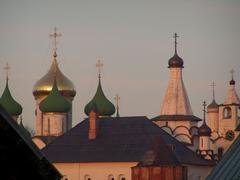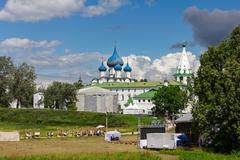
Rizopolozhensky Monastery Visiting Hours, Tickets, and Suzdal Historical Sites Guide
Date: 03/07/2025
Introduction
Nestled in the heart of Suzdal, Russia, the Rizopolozhensky Monastery stands as a remarkable symbol of Russian Orthodox spirituality, medieval architecture, and enduring cultural heritage. Founded in 1207, this historic convent has witnessed centuries of devotion, political change, and artistic achievement. Its close association with St. Yevfrosinia of Suzdal and its role as a sanctuary for noblewomen and a center for religious education underscore its profound spiritual significance. Today, the monastery draws both pilgrims and cultural enthusiasts, offering a window into Russia’s medieval monastic traditions through its white stone churches, iconic onion domes, and rich decorative art. For modern visitors, the monastery is accessible daily, with modest ticket prices, guided tours, and proximity to other notable Suzdal historical sites. This detailed guide provides essential information on visiting hours, ticketing, architectural highlights, travel tips, and the broader historical context, helping you plan a meaningful visit to one of Suzdal’s most treasured landmarks. Authoritative details are available via reputable resources such as Rusmania and the Suzdal Museum Reserve (Rusmania; Suzdal Museum Reserve).
Table of Contents
- Foundation and Early History
- St. Yevfrosinia of Suzdal and Monastic Life
- Architectural Evolution and Highlights
- Visiting Hours, Tickets, and Accessibility
- How to Get to Rizopolozhensky Monastery
- Visitor Facilities and Etiquette
- Guided Tours and Interpretation
- Role in Suzdal’s Religious and Social Life
- Impact of Secularization and Revival
- Nearby Attractions and Suggested Itineraries
- Practical Travel Tips
- Frequently Asked Questions (FAQ)
- Conclusion and Planning Resources
- Sources
Foundation and Early History
The Rizopolozhensky Monastery, also known as the Convent of the Deposition of the Robe, is among the oldest religious institutions in Suzdal. Established in 1207 amidst the rise of the Vladimir-Suzdal Principality, the monastery originally served as both a spiritual retreat and a stronghold of Orthodox tradition (Rusmania). Its foundation was part of a wider monastic expansion in medieval Rus’, with initial wooden buildings gradually replaced by stone as the monastery’s wealth and influence grew.
St. Yevfrosinia of Suzdal and Monastic Life
A pivotal figure in the monastery’s history is St. Yevfrosinia of Suzdal. After a personal tragedy, she entered the convent in 1233 and became its abbess. Her leadership and piety elevated the convent’s spiritual standing and attracted noblewomen and benefactors, transforming the monastery into a sanctuary and a center for religious education (Rusmania). Over the centuries, it has remained a place of refuge, contemplation, and community service.
Architectural Evolution and Highlights
Medieval Origins and Growth
While the original 13th-century buildings have not survived, the monastery’s architectural ensemble evolved over time, reflecting the styles and techniques of various eras (travelsetu.com; en.unistica.com). Notable features include:
- Rizopolozhensky Cathedral: Dating from the 16th century, this white-stone church exemplifies early Russian Orthodox design, with a cubic form, single dome, and restrained ornamentation (en.unistica.com).
- Holy Gates: Built in 1688, these Baroque-inspired gates feature ornate brickwork and mark the transition from the secular to the sacred (en.unistica.com).
- Bell Tower: The three-tiered structure, from the late 17th or early 18th century, serves as both a landmark and an acoustic marvel (travelsetu.com).
- Church of the Deposition of the Robe: Central to the complex, this church boasts harmonious proportions, onion domes, and rich interior frescoes (travelsetu.com).
The monastery’s defensive walls, refectory, and auxiliary buildings further illustrate its historical role as both a spiritual and communal stronghold.
Artistic and Cultural Heritage
Inside, visitors will find vivid frescoes, gilded iconostasis, and preserved manuscripts—testaments to the monastery’s ongoing role as a center of Russian ecclesiastical art (travelsetu.com). As part of the UNESCO-listed “White Monuments of Vladimir and Suzdal,” the complex benefits from ongoing conservation efforts.
Visiting Hours, Tickets, and Accessibility
- Opening Hours: Daily from 9:00 AM to 6:00 PM. Last admission is typically at 5:30 PM.
- Tickets: Admission to monastery grounds is usually free, but entry to certain buildings or exhibitions may require a ticket (100–300 RUB for adults). Discounts are available for students, seniors, and children; under 7s are often free.
- Guided Tours: Offered regularly in Russian and occasionally in English (advance booking recommended). Tours provide deep insights into history, architecture, and religious life.
- Accessibility: The monastery grounds have some paved paths and ramps, but uneven cobblestone and steps limit full wheelchair access. Contact the site in advance for specific accommodations.
For up-to-date information on hours and tickets, consult the Suzdal Museum Reserve or Suzdal tourism portal.
How to Get to Rizopolozhensky Monastery
Located at Ulitsa Rizopolozhenskaya, 34, on Suzdal’s eastern edge, the monastery is easily accessible:
- From Vladimir: Frequent buses (marshrutkas) connect Vladimir (a major railway hub) to Suzdal (about 45 minutes).
- Within Suzdal: A 10–15 minute walk from the central Market Square; taxis and bicycle rentals are also available.
- By Car: Free parking is available adjacent to the site, though spaces may be limited during festivals.
Visitor Facilities and Etiquette
- Restrooms: Located near the main entrance.
- Gift Shop: Sells icons, crafts, and books.
- Café: Open seasonally with refreshments.
- Dress Code: Modest attire is required. Women should cover their heads; men should remove hats and avoid shorts.
- Photography: Allowed outdoors; restricted inside churches or during services—always ask staff for guidance.
- Quiet and Respect: Maintain silence during services and avoid disruptive behavior.
Guided Tours and Interpretation
Organized by the Suzdal Museum Reserve, guided tours (lasting 45–60 minutes) are highly recommended for a deeper appreciation of the site’s history and art. English-language tours may require advance booking. Interpretive panels and occasional audio guides enhance the self-guided experience.
Role in Suzdal’s Religious and Social Life
The monastery has long served as a religious, educational, and charitable center, offering refuge to noblewomen and supporting local charitable initiatives. It remains active in Orthodox worship, with daily services and annual festivals—most notably the Feast of the Deposition of the Robe in July, which draws large crowds (Russian Orthodox Church Calendar).
Impact of Secularization and Revival
Closed in 1923 during Soviet anti-religious campaigns, the monastery suffered damage and repurposing. However, preservation efforts prevented total loss. Since its reopening in 1999, extensive restoration has revived both its spiritual and cultural life (Rusmania).
Nearby Attractions and Suggested Itineraries
Enhance your visit by exploring other Suzdal historical sites nearby:
- Suzdal Kremlin: Home to the Nativity Cathedral (Suzdal Kremlin)
- Pokrovsky Monastery: Famous for white-stone architecture
- Museum of Wooden Architecture: Open-air displays of traditional rural buildings (Museum of Wooden Architecture)
A suggested itinerary: Morning at Rizopolozhensky Monastery, lunch in Suzdal, then afternoon at the Kremlin and museums.
Practical Travel Tips
- Best Time to Visit: Late May to early September for mild weather and blooming gardens; winter visits offer snowy charm but require warm attire.
- Language: Russian is predominant; some staff speak English. Translation apps and basic Russian phrases are useful.
- Dining & Accommodation: Suzdal offers boutique hotels (e.g., Pushkarskaya Sloboda, Art Hotel Nikolaevsky Posad) and local restaurants serving classic Vladimir cuisine.
- Souvenirs: Icons, embroidered linens, ceramics, and monastery honey are popular choices.
- Safety: Suzdal is safe; maintain awareness of valuables in crowded areas.
Frequently Asked Questions (FAQ)
Q: What are the Rizopolozhensky Monastery’s visiting hours?
A: Open daily from 9:00 AM to 6:00 PM; check for seasonal variations.
Q: Are entrance fees required?
A: Grounds are generally free; some exhibitions/buildings require tickets (100–300 RUB).
Q: Is the site accessible for visitors with disabilities?
A: Some ramps exist, but full wheelchair access is limited. Contact in advance for assistance.
Q: Are guided tours available in English?
A: Occasionally, with advance booking; Russian tours are more frequent.
Q: Is photography allowed?
A: Generally outdoors only; restrictions apply inside churches and during services.
Conclusion and Planning Resources
The Rizopolozhensky Monastery embodies centuries of Russian religious, architectural, and cultural heritage. Its serene courtyards, exquisite frescoes, and active liturgical life offer a profound experience for all visitors. With its central location and proximity to other Suzdal historical sites, the monastery is an essential destination in Russia’s Golden Ring. For the most rewarding visit, plan ahead using official resources and consider guided or audio tours for deeper insight.
For updated details and planning tools, consult the Suzdal Museum Reserve website, the Suzdal tourism portal, and download the Audiala app for audio guides and offline maps.
Sources
- Rizopolozhensky Monastery in Suzdal: Visiting Hours, Tickets, and Historical Overview of a Majestic Suzdal Historical Site, 2025, Rusmania (Rusmania)
- Rizopolozhensky Monastery: Visiting Hours, Tickets, and Suzdal Historical Sites Guide, 2025, Touristplaces.guide (Touristplaces.guide)
- Rizopolozhensky Monastery Visiting Hours, Tickets & Architectural Highlights in Suzdal, 2025, Travelsetu.com (Travelsetu.com)
- Rizopolozhensky Monastery Visiting Hours, Tickets, and Guide to Suzdal Historical Sites, 2025, Suzdal Museum Reserve and Official Tourism (Suzdal Museum Reserve, Suzdal Tourism)











